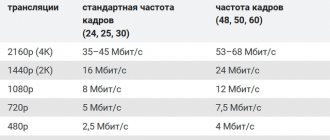What is Internet connection speed
Internet speed is the amount of information transmitted in one second. It is usually measured in bits, less often in bytes (for reference: there are 8 bits in 1 byte), although the latter seems more practical.
A quick Internet speed test can be carried out using the built-in Windows 8 programs; to do this, go to the “Start-Run” menu or by pressing the key combination “Winows + R” and, in the window that appears, execute the command “ping ya.ru -t”.
This function allows you to exchange small data packets of 32 bytes with the ya.ru website. You can judge the speed of the Internet by the response time. For a fast connection, these indicators will be within 10–30 ms; more than 2000 ms are considered very bad. If your connection is unstable, you can simply minimize this window; this will not “eat up” a lot of traffic (about 100 kB per hour) and will help your connection to be “in good shape” and monitor its speed at any time.
Claim by phone
An unreasonable drop in Internet speed indicates that there is some problem on the part of the provider. For example, when paying for a tariff of 100 megabits, the user receives no more than 60 or even less. But there is a nuance here: there is no violation of the contract on the part of the provider, since there are no guaranteed speeds in the contract, it says up to 100 megabits per second, so even 2 megabits are legal.
But still, calling the operator is not prohibited. By raising complaints, you can achieve a significant improvement in the situation - if they see that the channel really has problems, they will fix it. At the same time, you can get advice on the optimal setup of the equipment. You should call the number: 88001000800.
You can also complain about the quality of communication to other authorities.
Possible speed problems
Here is a list of the most common connection speed problems:
- provider restrictions. The reason that the connection speed has become lower than declared may be: too much load on the network, reaching a certain amount of traffic, speed limits at different times of the day;
- server restrictions. Not all sites have sufficient resources to maintain high speed when working with a large number of users;
- the congestion of your communication channel with the work of background applications, such as updating Windows 8, downloading new virus databases, running Trojans and spyware, etc.;
- lack of computer resources. Outdated hardware and the simultaneous launch of a large number of applications (including viruses that can work unnoticed) can cause low Internet speed, even if these programs do not use it;
- incorrect configuration of network equipment. Network card, router, modem - any of these devices, if configured incorrectly, will affect the connection speed.
Changing tariff plan
The most obvious problem with slow internet is tariff restrictions. If your tariff is 50 megabits per second, then no free channels will give you 150 megabits. Therefore, to speed up the Internet, simply change the tariff. Rostelecom's tariff schedule is constantly updated, new options are added, and this year a tariff is offered at speeds of 250 megabits per second, which is much higher than standard solutions. In order to change the tariff, you need:
- Log into your personal account on the provider’s website, select the tariff with high-speed Internet you like in the appropriate section and click “Connect”. Here you can immediately pay for the new package.
- You can call technical support / customer service, indicate your LSA number, and ask to change the tariff to the one you like.
- Change the tariff at the nearest Rostelecom office. You must have your passport with you.
Important! To connect to the Internet at 250 megabits per second, you will need a special router; standard equipment does not support this speed. Either you go to the store, or you rent or buy from a provider, then they will install and configure everything themselves.
Solution
In order to increase the speed of your Internet connection if you have insufficient experience in setting up a computer, software or additional devices, the best choice would be to contact specialists. If you want to understand for yourself how to find out the reasons for data transfer at a low speed, we suggest that you familiarize yourself with the most effective ways to solve this problem.
What to do if the Internet speed is low:
- Please carefully read the contract for the provision of Internet communication services. Perhaps the reason for the low speed lies there.
- Consult your provider's technical support service. They ask people “Why are my downloads slow” many times a day and they know most of the reasons by heart.
- install antivirus and firewall. If your computer is not powerful enough, it is better to use programs that are not too resource-intensive. For example, Avira Antivir and Outpost Firewall. The latter in “learning mode” will ask you for permission to provide network access to any program. This will help you find out which applications are using the Internet.
- if you are using a non-standard operating system (beast, extreme, GameEdition, etc.), it is better to replace it with the original one. Often the reason lies in incorrect shell settings.
If the above measures do not have an effect, try changing the settings of your equipment, namely your router.
Perhaps the whole point is in the passage of the signal through the router; very low speed in this case may be due to the following reasons:
- Your neighbor’s router operates at the same frequency as yours;
- the number of open channels leads to either slowdown or interference with the operation of the device;
- the signal level does not allow you to reach the maximum speed;
- The router is using outdated hardware or software.
Changing the channel in the router
One of the reasons for low Internet speed via wifi may be overload of the router channel being used. If there are several wireless networks in your area with similar settings, it is likely that your routers are using the same channels, which is causing the network to slow down.
To change the router settings you need to go to its control panel. To do this, you need to enter 192.168.0.1 or 192.168.1.1 in the address bar of your browser; it is usually located at this address.
There we look for menu items whose names will include the word “channel”, you need to set the channel to auto-detection, in this case the device will independently search for a free frequency.
Number of simultaneous connections
It is also worth paying attention to such a parameter as the number of simultaneous connections (Current Connected Wireless Stations numbers or something similar). The security level of your home wireless connection is often too much to stop skilled hackers.
To achieve this, router manufacturers have provided another protection option - limiting the number of devices. If you use a constant number of wireless devices, feel free to indicate their number, everyone else simply will not be able to connect.
Measuring the speed of wifi connection
If suspicions about the reasons for the decrease in speed fall on the router, there is an easy way to confirm or refute them. To find out what your outgoing (incoming) Internet speed is, today there are many Internet resources, such as: www.bravica.net, www.speedtest.net or NetWorx, DUTrafic programs.
For example, in order to check why there is a slow connection on a laptop, you should first disable all programs on it that use the Internet. Next, you need to take measurements on a wireless device using one of the methods indicated above. After that, connect it using a cable and repeat the procedure. If the speed differs by more than 10%, then the router really reduces it.
Ways to increase speed
- Reducing the number of connections.
- Setting up auto-detection of the data transmission channel.
- Replacing the router with a device that uses a more modern connection protocol or flashing the old one (today the 802.11ac protocol is considered the most modern).
- Connecting a more powerful antenna to the router will give a better signal in areas with interference and improve data transfer speeds.
- If your provider uses a VPN protocol and there is an opportunity to change it, do this by choosing one that uses the DHCP or PPPoE protocols (on a static IP address).
Incorrect operation of network equipment
If you use a Wi-Fi router at home, then very often the problem may lie there. Some of the most popular reasons for its incorrect operation are overheating, dust getting on the chips, and firmware failure. What to do in this case?
- Just reboot your router. To do this, turn off the power for 20-30 seconds, then turn it on again.
- If that doesn't help, reboot through the settings web interface. You can read how to get into it in the instructions for your device or in this article on our website. Usually the required item is located in the system settings section.
- If the speed is still low, try connecting to your computer's network card directly. If your provider provides access via dynamic IP, you do not need to make any additional settings. If using some other technology, check with technical support how to correctly enter the settings for direct connection. Now check the speed. If it is high, one of the last steps will be to reset the router.
- Reset your router. To do this, go to the settings web interface through any browser and find the corresponding function in the system settings section. After this, re-enter all connection parameters.
If, even after the reset, the Internet speed is low when connecting through a router, there is only one way out - buy a new device. If you live in an apartment, you can get by with an inexpensive device; it will serve you for many years.
Internet speed from providers MTS, Megafon, ByFly, Beeline, Ukrtelecom is reduced
Most wireless and sometimes cable Internet providers limit the speed. The problem is this: access to the World Wide Web is carried out through the same channels as communication, which is why, even with a good network signal, the speed will still be low.
As for cable providers, the problem is the same - to prevent network congestion, they set internal restrictions, often without the consent of customers. There is only one way to combat this - complaints and persistent demands.
Let's take a closer look at the mobile Internet speed limits of different providers.
MTS
Depending on the tariff plan, 50 or 100 MB per day can be provided without a speed limit; everything provided above is limited to a speed of 64 kbit/s. There are monthly tariffs - 3,4,6,20 or 50 GB. Once the limit is exceeded, Internet use is blocked.
Video: how to increase Internet speed
Megaphone
Offers monthly tariffs without limitation of reception speed with maximum traffic of 70 MB and 3,7,15,30 GB. Once this volume is exhausted, access to the service is blocked.
ByFly
This is a cable operator. Its service packages start at 1 Mbit/s and end at 50 Mbit/s. However, it should be remembered that wired Internet also experiences difficulties in areas where there are no fiber optic lines and with the stated 1-2 Mbits, the actual reception speed will be 512 kbit/s, and the output speed will be 256 kbit/s.
Beeline
This company today provides both mobile and wired Internet services. In the latter, the speed varies from 10 to 100 Mbit, there are tariffs with a speed limit upon reaching a certain traffic threshold, and there are also without it. Mobile Internet differs only in the amount of traffic provided within a certain tariff. The declared speed is up to 256 kbit/s, the real one can drop to 32 kbit/s, it all depends on the network load.
Ukrtelecom
It provides both wireless Internet services using 3G technology, which provides speeds of up to 7.2 Mbit/s, and cable fiber-optic connections, the speed of which can be up to 5 Mbit/s without traffic limitation.
Reduced Internet speed can have a variety of reasons, from banal website restrictions to interference with the operation of your equipment and unauthorized people working through a wifi router. The first step to identifying this problem is to constantly monitor your Internet speed using any of the means suggested above.
If you are convinced that there is an underestimation, begin to act according to the plan proposed above:
- calls to the provider's technical support;
- setting up or changing software;
- reflashing or replacing equipment.
Verification methods
To test the Wi-Fi network, websites and programs have been created for computers and smartphones. In order not to install unnecessary programs, we will consider sites that are accessed via the Internet. And if the speed suddenly drops, sites like speedtest can provide actual confirmation of this fact. Let's look at the list of sites that allow you to check your speed.
Full list
This is a shortened list of resources for the test. A detailed description of all testing methods is provided in a special section. But you should measure it on at least two resources (just not in parallel!). This will eliminate all verification inaccuracies. When the speed fluctuates, testing allows you to measure these very fluctuations. And it doesn’t matter how much the test shows. It is more important to know what to do if the results do not meet expectations!
Obsolescence of diagnostic tools
In the modern world, diagnostics, unfortunately, are not very revealing. Firstly, because it is based on 40-year-old protocols (RFC 792 - from 1981) and turns into a magnifying glass in the era of electron microscopes. And secondly, these protocols have big security problems. If a router fully complies with RFC 792, then it can be easily attacked using a DDoS attack (which is what hackers dabbled in in the 2000s). Therefore, even these protocols do not work well due to the screws being tightened.
A direct consequence of these limitations is a typical scenario for solving network problems:
The user contacts the provider and says that he has problems with site A and poor connection. The provider usually always says: everything is fine with us, the site has problems.
When a user contacts site support, they tell him the same thing - everything is fine with us, contact your provider.
As a result, the problem, of course, is not solved.
Below we will still try to determine where exactly the problem is.
Unfortunately for the article, and fortunately for the author, the author has everything in order with the Internet. Therefore, there will be practically no examples of “look, everything is bad on the left, but everything is good on the right.” But, where possible, I will still try to break something for clarity.
Number of connected devices
The user is able to directly influence the speed of the network. If 6 devices are connected to the router at once, each device will experience slower operation. Alas, a standard for Wi-Fi network operation, in which all devices receive full speed, has not yet been developed. Therefore, everyone who connects reduces the speed for other network participants.
Let's look at a specific example: a laptop and a smartphone are connected to the router. We measure the speed in this case. Let's connect a couple more smartphones. The maximum speed naturally drops. There is only one caveat. The decrease will occur when everyone actively uses the Internet. For example, when watching a video. The number of devices limits the speed less than the traffic usage of those devices. When connected passively (for example, the smartphone is simply charging and does not update programs), the device has minimal impact.
Speed is lost and falls according to a very obvious pattern: it is evenly distributed among users. But it may shift in one direction. It depends on the activity of use. A phone simply connected to the network will quickly lose priority. But the laptop on which a large file is downloaded will take this very part for itself.
Therefore, to solve the problem, it may be useful to use the order of use or disable unnecessary devices. Naturally, if you have access to them.
Wi-Fi Signal Strength
Sometimes neighbors are to blame for poor speed. Not out of malice, it’s just that the transmitting antennas, being nearby, interfere with each other’s signal. This is especially true if Wi-Fi routers are from the same provider and are located nearby.
Let's assume that 2 points are separated by a wall and hang back to back. These are 2 identical routers that operate on the same frequency and the same channel. Interference is induced at a regular frequency and, as a result, the points constantly shuffle channels and switch operating modes (during auto-tuning).
How to fix a power problem
There are 3 options:
- immediately choose a router that is different from your neighbor’s. An important step because it involves communication and pre-planning;
- move the router to another location. Once at a distance, the points will create less interference in the work. Thus, it is possible, without changing anything, to increase the speed, quality of the signal and its stability;
- replace the WiFi router with a better one.
Not always one of these solutions allows you to increase speed. It may happen that changing the location of the router will not affect the interaction with devices at all. For this case, there is an additional solution: the router may have the option to change the signal strength.
Changing the signal strength
If Wi- Fi is slow, you can try switching the signal strength. It is not necessary to increase it, sometimes it needs to be lowered.
If the speed has decreased, we return the parameters back. The speed has increased - leave it as is.
For some devices (iPhone, Samsung Galaxy smartphones, most Chinese smartphones), reducing the transmitter power has exactly the opposite effect - increasing signal quality and network speed. This is the wireless paradox.










